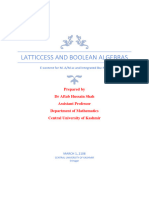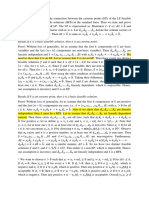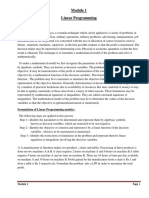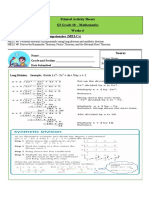0 ratings0% found this document useful (0 votes)
622 views5 Hermitian and Skew-Hermitian Matrices: Definitions: A Matrix With Complex Elements Is Said To
5 Hermitian and Skew-Hermitian Matrices: Definitions: A Matrix With Complex Elements Is Said To
Uploaded by
Jessica ReddyCharles Hermite proved an important theorem in 1855 concerning matrices A where A = A*, which are now called Hermitian matrices. Hermitian and skew-Hermitian matrices are generalizations of real symmetric and real skew-symmetric matrices, respectively. A matrix A is Hermitian if A = A* and skew-Hermitian if A = -A*. The document then provides examples and theorems about properties of Hermitian and skew-Hermitian matrices.
Copyright:
© All Rights Reserved
Available Formats
Download as PDF, TXT or read online from Scribd
5 Hermitian and Skew-Hermitian Matrices: Definitions: A Matrix With Complex Elements Is Said To
5 Hermitian and Skew-Hermitian Matrices: Definitions: A Matrix With Complex Elements Is Said To
Uploaded by
Jessica Reddy0 ratings0% found this document useful (0 votes)
622 views4 pagesCharles Hermite proved an important theorem in 1855 concerning matrices A where A = A*, which are now called Hermitian matrices. Hermitian and skew-Hermitian matrices are generalizations of real symmetric and real skew-symmetric matrices, respectively. A matrix A is Hermitian if A = A* and skew-Hermitian if A = -A*. The document then provides examples and theorems about properties of Hermitian and skew-Hermitian matrices.
Original Title
M_1.5_RM
Copyright
© © All Rights Reserved
Available Formats
PDF, TXT or read online from Scribd
Share this document
Did you find this document useful?
Is this content inappropriate?
Charles Hermite proved an important theorem in 1855 concerning matrices A where A = A*, which are now called Hermitian matrices. Hermitian and skew-Hermitian matrices are generalizations of real symmetric and real skew-symmetric matrices, respectively. A matrix A is Hermitian if A = A* and skew-Hermitian if A = -A*. The document then provides examples and theorems about properties of Hermitian and skew-Hermitian matrices.
Copyright:
© All Rights Reserved
Available Formats
Download as PDF, TXT or read online from Scribd
Download as pdf or txt
0 ratings0% found this document useful (0 votes)
622 views4 pages5 Hermitian and Skew-Hermitian Matrices: Definitions: A Matrix With Complex Elements Is Said To
5 Hermitian and Skew-Hermitian Matrices: Definitions: A Matrix With Complex Elements Is Said To
Uploaded by
Jessica ReddyCharles Hermite proved an important theorem in 1855 concerning matrices A where A = A*, which are now called Hermitian matrices. Hermitian and skew-Hermitian matrices are generalizations of real symmetric and real skew-symmetric matrices, respectively. A matrix A is Hermitian if A = A* and skew-Hermitian if A = -A*. The document then provides examples and theorems about properties of Hermitian and skew-Hermitian matrices.
Copyright:
© All Rights Reserved
Available Formats
Download as PDF, TXT or read online from Scribd
Download as pdf or txt
You are on page 1of 4
5
Hermitian and Skew-Hermitian Matrices
Charles Hermite (1822-1901), in 1855, proved an
important theorem concerning any matrix 𝑨 for which
𝑨 = 𝑨∗ , resulting in such matrices being named after him.
Hermitian and Skew-Hermitian matrices are
generalizations of real symmetric and real skew-symmetric
matrices respectively.
Definitions: A matrix 𝑨 with complex elements is said to
be Hermitian if 𝑨 = 𝑨∗ (conjugate transpose), that is, the
(𝑖, 𝑗)𝑡 element 𝑎𝑖𝑗 is the complex conjugate of the (𝑗, 𝑖)𝑡
element, 𝑎𝑗𝑖 = 𝑎𝑖𝑗 , that is,
𝑎11 𝑎12 ⋯ 𝑎1𝑚
𝑎 𝑎22 ⋯ 𝑎2𝑚
𝑨 = 12
⋮ ⋮ ⋱ ⋮ ,
𝑎1𝑚 𝑎2𝑚 ⋯ 𝑎𝑚𝑚
where the 𝑎𝑖𝑖 , 𝑖 = 1, … , m, are real.
and 𝑨 skew-hermitian if 𝑨 = −𝑨∗ , that is, the (𝑖, 𝑗)𝑡 element
𝑎𝑖𝑗 𝑖𝑠 − 1 times the complex conjugate of the (𝑗, 𝑖)𝑡 element,
−𝑎𝑗𝑖 = 𝑎𝑖𝑗 , that is,
𝑎11 𝑎12 ⋯ 𝑎1𝑚
−𝑎12 𝑎22 ⋯ 𝑎2𝑚
𝑨= ⋮ ⋮ ⋱ ⋮ ,
−𝑎1𝑚 −𝑎2𝑚 ⋯ 𝑎𝑚𝑚
where the 𝑎𝑖𝑖 , 1 ≤ 𝑖 ≤ 𝑚 is either zero or purely imaginary.
Example: If 𝑎, 𝑏, 𝑐, 𝑑, 𝑒, 𝑓, 𝑔, , 𝑘 are real numbers and if
𝑖 = −1, then
𝑎 𝑏 + 𝑖𝑐 𝑒 + 𝑖𝑓
𝑏 − 𝑖𝑐 𝑑 + 𝑖𝑘
𝑒 − 𝑖𝑓 − 𝑖𝑘 𝑔
is hermitian and
𝑖𝑎 𝑏 + 𝑖𝑐 𝑒 + 𝑖𝑓
−𝑏 + 𝑖𝑐 𝑖𝑑 + 𝑖𝑘
−𝑒 + 𝑖𝑓 − + 𝑖𝑘 𝑖𝑔
is skew-hermitian.
Theorem: A Hermitian (skew-Hermitian) matrix is square,
and a real Hermitian (skew-Hermitian) matrix is symmetric
(skew-symmetric).
Proof: The proof that Hermitian and skew-Hermitian
matrices are square is left to the student. If 𝑨 is real
𝑇
Hermitian, then 𝑨 = 𝑨∗ = 𝑨 = 𝑨𝑇 , and 𝑨 is symmetric; if 𝑨
𝑇
is real skew-Hermitian, then 𝑨 = −𝑨∗ = − 𝑨 = −𝑨𝑇 , and
𝑨 is skew-symmetric.
We now list some theorems whose straightforward proofs
are left as exercises for the student.
Theorem: If 𝑨 is Hermitian (skew-Hermitian), then 𝑖𝑨 and
– 𝑖𝑨 are skew-Hermitian (Hermitian).
Theorem: If 𝑨 is Hermitian, then 𝑨 = 𝑴 + 𝑖𝑵, where 𝑴 is
real symmetric and 𝑵 is real skew-symmetric.
Theorem: If 𝑨 is a square matrix, then 𝑨 + 𝑨∗ is Hermitian
and 𝑨 − 𝑨∗ is skew-Hermitian.
Theorem: Any square matrix can be expressed as the sum
of a Hermitian and a skew-Hermitian matrix.
Theorem: If 𝑨 is any matrix (not necessarily square), then
𝑨∗ 𝑨 and 𝑨𝑨∗ are both Hermitian.
Theorem: If 𝑨 is Hermitian, then so also is 𝑩∗ 𝑨𝑩 for every
conformable matrix (a matrix is conformable if its
dimensions are suitable for defining some operations) 𝑩.
Some more Results
1. 𝑨 𝑚 × 𝑚 real: 𝑨 is Hermitian ⟺ A is symmetric.
2. 𝑨, 𝑩 𝑚 × 𝑚 Hermitian, 𝑐 ∈ ℝ:
a. 𝑐𝑨 is Hermitian.
b. 𝑨 ± 𝑩 is Hermitian.
c. 𝑨𝑩 = 𝑩𝑨 ⇔ 𝑨𝑩 is Hermitian.
d. 𝑨 ⊙ 𝑩 is Hermitian.
3. 𝑨 𝑚 × 𝑚 Hermitian, 𝑩 𝑛 × 𝑛 Hermitian:
a. 𝑨 ⊗ 𝑩 is Hermitian
b. 𝑨 ⊕ 𝑩 is Hermitian
4. 𝑨 = 𝑎𝑖𝑗 𝑚 × 𝑚 Hermitian:
a. 𝑨𝑇 is Hermitian.
b. 𝑨∗ is Hermitian.
c. 𝑨−1 is Hermitian, if 𝐴 is nonsingular.
d. 𝑨𝑖 is Hermitian for 𝑖 = 1,2, …
e. 𝑨 is Hermitian.
f. 𝑨 𝑎𝑏𝑠 is Hermitian.
g. 𝑨∗ 𝑨 = 𝑨𝑨∗ , that is, 𝐴 is normal.
5. 𝑨 𝑚 × 𝑚 :
a. 𝑨𝑨∗ is Hermitian
b. 𝑨∗ 𝑨 is Hermitian.
c. Three exist unique Hermitian 𝑚 × 𝑚 matrices 𝑩, 𝑪
such that 𝑨 = 𝑩 + 𝑖𝑪.
6. 𝑨 𝑚 × 𝑚 : 𝑨 is Hermitian ⟺ 𝑨∗ 𝑨 = 𝑨.
You might also like
- STAT 480b Answer Key To Problem Set No. 4Document3 pagesSTAT 480b Answer Key To Problem Set No. 4Robinson Ortega MezaNo ratings yet
- Low-Speed Aerodynamics, Second Edition PDFDocument29 pagesLow-Speed Aerodynamics, Second Edition PDFWei Gao100% (1)
- Lattices and Boolean AlgebrasDocument93 pagesLattices and Boolean Algebrasrehan8856811155No ratings yet
- IGNOU - Lecture Notes - Linear AlgebraDocument29 pagesIGNOU - Lecture Notes - Linear Algebraruchi21julyNo ratings yet
- Statistical InferenceDocument55 pagesStatistical Inferenceshamilabdulazeez9No ratings yet
- Elements of Sets and Logic Lecture Manal by Chebet EliDocument18 pagesElements of Sets and Logic Lecture Manal by Chebet Elichebeteli4No ratings yet
- Matrices DefinitionDocument32 pagesMatrices Definitionshantan02100% (1)
- 4.1 Point and Interval EstimationDocument30 pages4.1 Point and Interval EstimationShamuel AlasNo ratings yet
- Holiday Homework Class Xii MathDocument4 pagesHoliday Homework Class Xii Mathmanish kumarNo ratings yet
- 2nd PU Maths Midterm Paper 2Document5 pages2nd PU Maths Midterm Paper 2Ravichandra SNo ratings yet
- Module 7 - Determinants - CETDocument22 pagesModule 7 - Determinants - CETGokul yadavNo ratings yet
- Vector Algebra Tutorial QuestionsDocument5 pagesVector Algebra Tutorial Questionsmubbaah100% (1)
- Recurrence Relation Presentation MEERADocument27 pagesRecurrence Relation Presentation MEERAKruti0% (1)
- AN35M34Document4 pagesAN35M34ujjwal gowda100% (1)
- Practice Question Matrix OneDocument4 pagesPractice Question Matrix OneOlatundeNo ratings yet
- Two-Way Classification (With One Observation Per Cell) :: y I P QDocument7 pagesTwo-Way Classification (With One Observation Per Cell) :: y I P QKhos Mahmuda AkterNo ratings yet
- 27 Principal Ideal Domains and Euclidean Rings: 1 1 K K I IDocument14 pages27 Principal Ideal Domains and Euclidean Rings: 1 1 K K I ISamraNo ratings yet
- Unit-10 IGNOU STATISTICSDocument31 pagesUnit-10 IGNOU STATISTICSCarbidemanNo ratings yet
- Feb 24 - Linear Transformation QuestionsDocument3 pagesFeb 24 - Linear Transformation QuestionsparshotamNo ratings yet
- Real Analysis ReviewDocument65 pagesReal Analysis ReviewLie ZelNo ratings yet
- 18.1 Second-Order Euler EquationsDocument14 pages18.1 Second-Order Euler EquationsMunir AslamNo ratings yet
- MatricesDocument3 pagesMatricesbeponil535100% (1)
- Fundamental Theorem of Linear ProgrammingDocument2 pagesFundamental Theorem of Linear ProgrammingGaurav GuptaNo ratings yet
- II Sem B.Sc. (NEP) Mathematics Lab Manual UOMDocument48 pagesII Sem B.Sc. (NEP) Mathematics Lab Manual UOMrakshajain287100% (1)
- MMC2020 SolutionsDocument9 pagesMMC2020 SolutionsRahul Majgavakar100% (1)
- Power SeriesDocument55 pagesPower SeriesFaizNo ratings yet
- Devc Unit-III, IV & V Question BankDocument2 pagesDevc Unit-III, IV & V Question BankPavani KaramalaNo ratings yet
- 8.3 The Range: Section I (Sequence)Document15 pages8.3 The Range: Section I (Sequence)Manish Acharyya ECENo ratings yet
- Queueing - Theory-Birth and Death ProcessDocument72 pagesQueueing - Theory-Birth and Death ProcessRohanNo ratings yet
- Eigenvalues Eigenvectors and Differential EquationsDocument56 pagesEigenvalues Eigenvectors and Differential Equations322399mk7086No ratings yet
- Chapter 1 Metric SpacesDocument17 pagesChapter 1 Metric Spacesribeiro_sucesso100% (1)
- Lecture 9 - Discrete Fourier Transform and Fast Fourier Transform (I)Document19 pagesLecture 9 - Discrete Fourier Transform and Fast Fourier Transform (I)Sadagopan RajaNo ratings yet
- Linear Regression: Major: All Engineering Majors Authors: Autar Kaw, Luke SnyderDocument25 pagesLinear Regression: Major: All Engineering Majors Authors: Autar Kaw, Luke Snydergunawan refiadi100% (1)
- Matrices UpdateDocument6 pagesMatrices Updateapi-349545585100% (1)
- Mca Notes - m-1Document25 pagesMca Notes - m-1Yash GuptaNo ratings yet
- Numerical Solutions of Algebraic and Transcendental EquationsDocument22 pagesNumerical Solutions of Algebraic and Transcendental EquationsGyan Ranjan KumarNo ratings yet
- MM-Limits and ContinuityDocument22 pagesMM-Limits and ContinuityKim Say Chun / Sc.KIMNo ratings yet
- Unit-15 IGNOU STATISTICSDocument18 pagesUnit-15 IGNOU STATISTICSCarbidemanNo ratings yet
- Numerical Approximation of Poisson Equation Using The Finite Difference MethodDocument8 pagesNumerical Approximation of Poisson Equation Using The Finite Difference MethodIJRASETPublicationsNo ratings yet
- SOLVING Lines and PlanesDocument11 pagesSOLVING Lines and PlanesheneryNo ratings yet
- Solving Differential EquationsDocument5 pagesSolving Differential Equationswolfretonmaths100% (1)
- WINSEM2020-21 MAT1014 TH VL2020210505929 Reference Material I 08-Apr-2021 1-Group Homomorphism Isomorphism and Related ExamplesDocument27 pagesWINSEM2020-21 MAT1014 TH VL2020210505929 Reference Material I 08-Apr-2021 1-Group Homomorphism Isomorphism and Related ExamplesMoulik AroraNo ratings yet
- Kharrat-Toma Transform and Its Application in Solving Some Ordinary Differential Equations With Initial Boundary ConditionsDocument6 pagesKharrat-Toma Transform and Its Application in Solving Some Ordinary Differential Equations With Initial Boundary ConditionsInternational Journal of Innovative Science and Research TechnologyNo ratings yet
- Design of Experiments Notes - IIT DelhiDocument352 pagesDesign of Experiments Notes - IIT DelhivicksgeorgeNo ratings yet
- Worksheet MatricesDocument2 pagesWorksheet MatricesPristy Joyis100% (1)
- Statistical Inference Book PDFDocument350 pagesStatistical Inference Book PDFAksNo ratings yet
- Discrete MathematicsDocument75 pagesDiscrete MathematicsJean Rances Amparo RanidoNo ratings yet
- Week02 Relations and FunctionsDocument33 pagesWeek02 Relations and FunctionsRooshan JavedNo ratings yet
- 5 L L EC533: Digital Signal Processing: DFT and FFTDocument20 pages5 L L EC533: Digital Signal Processing: DFT and FFTDalia Abou El MaatyNo ratings yet
- Week 13Document17 pagesWeek 13JavierPaganLacambraNo ratings yet
- 1.2 Well Formed FormulasDocument17 pages1.2 Well Formed FormulasHariNo ratings yet
- Unit - I Logic and Proofs: Ma8351 Discrete MathematicsDocument45 pagesUnit - I Logic and Proofs: Ma8351 Discrete MathematicsMr PerfectNo ratings yet
- Complex Numbers - Introduction PDFDocument23 pagesComplex Numbers - Introduction PDFhamxafarrukh100% (1)
- Moment Generating FunctionDocument5 pagesMoment Generating FunctionMohankumar RamachandranNo ratings yet
- Unbiased EstimatorDocument70 pagesUnbiased EstimatorSergioNo ratings yet
- Chapter 6. Comparison of Several Multivariate MeansDocument9 pagesChapter 6. Comparison of Several Multivariate MeansAiman Ajmal100% (1)
- Methods of Integration: Substitution MethodDocument42 pagesMethods of Integration: Substitution MethodMajak MarialNo ratings yet
- Linear Regression ModelDocument3 pagesLinear Regression ModelmarkkkkkkkheeessNo ratings yet
- DocumentDocument2 pagesDocumentSwedhaNo ratings yet
- Maths P1 SheetDocument15 pagesMaths P1 Sheet4abhisheksaxenaNo ratings yet
- MatrixDocument22 pagesMatrixlorago3042No ratings yet
- Gupta 2017Document8 pagesGupta 2017ficuniNo ratings yet
- B F1032 Pages: 3: Answer All Questions, Each Carries 5 MarksDocument3 pagesB F1032 Pages: 3: Answer All Questions, Each Carries 5 MarksAfsal Abdul KarimNo ratings yet
- MULTIPLE CHOICE. Choose The One Alternative That Best Completes The Statement or Answers The QuestionDocument2 pagesMULTIPLE CHOICE. Choose The One Alternative That Best Completes The Statement or Answers The QuestionMuhammadNo ratings yet
- 3200 MCQ Instrumental EnggDocument16 pages3200 MCQ Instrumental EnggAryan ThakurNo ratings yet
- MATHSDocument9 pagesMATHSitsroshNo ratings yet
- Unit 3 Integration: StructureDocument33 pagesUnit 3 Integration: StructureThe FZ25 BoyNo ratings yet
- T7 Sturm Liouville Problems SolutionsDocument6 pagesT7 Sturm Liouville Problems SolutionsShlôkä JõshïNo ratings yet
- Integration 1Document2 pagesIntegration 1Himanshu RaghuwanshiNo ratings yet
- Printed Activity Sheets QI Grade 10 - Mathematics Weeks 6Document7 pagesPrinted Activity Sheets QI Grade 10 - Mathematics Weeks 6Mangligot JeffreyNo ratings yet
- Common Fixed Point Theorem For Weakly Compatible Mappings in Complex Valued Metric Spaces Using Identity FunctionDocument5 pagesCommon Fixed Point Theorem For Weakly Compatible Mappings in Complex Valued Metric Spaces Using Identity FunctionAndi Muhammad SyahrulNo ratings yet
- Lecture Notes CombinatoricsDocument145 pagesLecture Notes CombinatoricsAGNo ratings yet
- Bergstrom 2000Document13 pagesBergstrom 2000Angel CerriteñoNo ratings yet
- Shake TheoryDocument8 pagesShake Theorymansoor_yakhchalian2No ratings yet
- IB MAA SL Calculus PracticeDocument13 pagesIB MAA SL Calculus PracticeXiyue ChenNo ratings yet
- Angular Momentum, Laplacian and Gradient in Spherical Coordinates - IzveduvanjeDocument3 pagesAngular Momentum, Laplacian and Gradient in Spherical Coordinates - IzveduvanjeElena KusevskaNo ratings yet
- Lesson01 Computational ModellingDocument36 pagesLesson01 Computational ModellingIñigoAlberdiNo ratings yet
- Chapter 5 Part 2 Bode PlotDocument45 pagesChapter 5 Part 2 Bode PlotumarNo ratings yet
- Geoffrey R. Grimmett - One Thousand Exercises in Probability SolutionDocument305 pagesGeoffrey R. Grimmett - One Thousand Exercises in Probability Solutionmeko1986100% (13)
- Preface 2002 Linear Algebra and Its ApplicationsDocument2 pagesPreface 2002 Linear Algebra and Its ApplicationsvahidNo ratings yet
- Maximumminimu Probs IntroDocument3 pagesMaximumminimu Probs IntroConnieChenNo ratings yet
- Eigen Value Eigen Vector and DiagonalizationDocument19 pagesEigen Value Eigen Vector and Diagonalizationvolatility75sNo ratings yet
- The Divergence TheoremDocument4 pagesThe Divergence TheoremAdamAlfathNo ratings yet
- Instructor (Stephen Boyd) :yeah, I Guess This Means We've Started. So Welcome ToDocument22 pagesInstructor (Stephen Boyd) :yeah, I Guess This Means We've Started. So Welcome ToigormassaoNo ratings yet
- JawapanDocument114 pagesJawapanm-9526276No ratings yet
- Chapter 2Document28 pagesChapter 2nurul najwaNo ratings yet
- Fractional Order Control a TutorialDocument15 pagesFractional Order Control a Tutorialhemamalla1804No ratings yet
- Nonlinear Computational MechanicsDocument8 pagesNonlinear Computational MechanicsAniruddh Faujdar0% (1)
- Chapter 1Document48 pagesChapter 1CharleneKronstedtNo ratings yet
- Lab - Exp - 1 and 2Document5 pagesLab - Exp - 1 and 2RUTUJA MADHURENo ratings yet

























































































